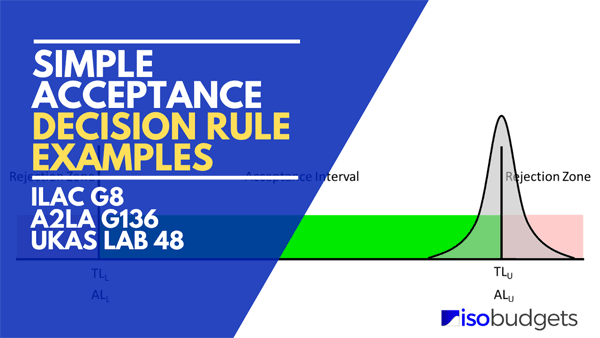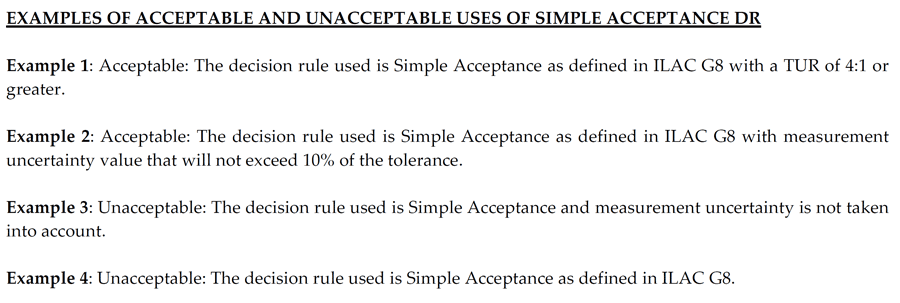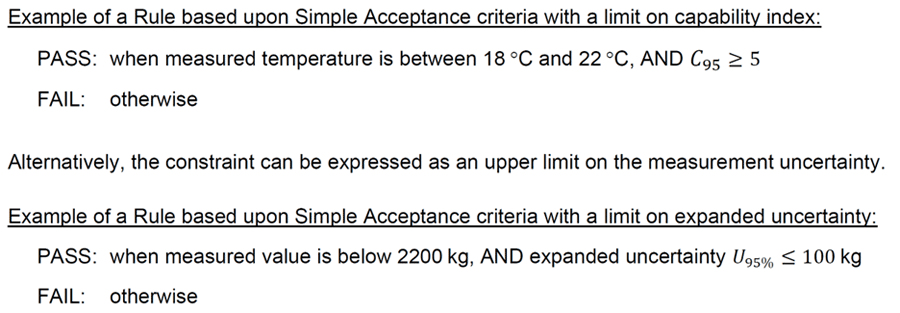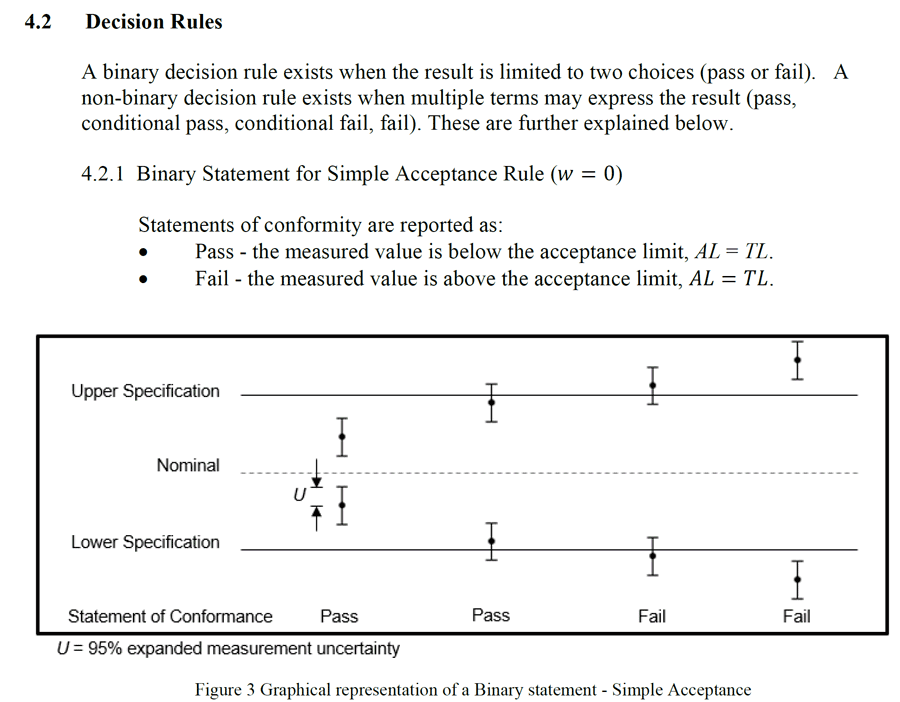
Introduction
Simple acceptance is a decision rule that has been around for a long time (whether you knew what it was named or not). The best way to explain it is a set of rules used to determine whether a test or measurement result passes or fails based on the tolerance limits. Typically, the decision rules that most of us have used to determine conformity are:
- If a result is within tolerance, it Passes; or
- If a result is out of tolerance, it Fails.
Sounds familiar, right?
Well, this is simple acceptance on an easy level that most of us can understand.
Unfortunately, there are a lot of smart people that do a great job of making simple things difficult.
While there are several different interpretations on the decision rule definition and the application of simple acceptance, the purpose of this guide is to help you draft decision rules based on simple acceptance; not debate how measurement uncertainty is or is not taken into account.
So, look at the examples in this guide, read your accreditation body’s policy and requirements documents, and draft a set of decision rules that meet the requirements of your laboratory, customers, and accreditation body.
In this guide, you will learn the following:
- Simple acceptance definition,
- Other definitions related to simple acceptance,
- Examples of simple acceptance decision rules, and
- Recommended guides about simple acceptance.
If this is the information that you are looking for, then keep reading. This guide is for you.
Simple Acceptance Definition

According to the ILAC G8, simple acceptance is defined as a decision rule where the acceptance limit is the same as the tolerance limit.
Furthermore, ILAC G8 classifies simple acceptance as a binary decision rule because it only has two choices (e.g. Pass or Fail).
Based on the definition, simple acceptance is commonly abbreviated as AL = TL (i.e. acceptance limit is the same as the tolerance limit). Additionally, many guides and labs will refer to this as:
- guard banding factor of zero (i.e. w = 0), or
- shared risk
Simple acceptance is referred to as “shared risk” because the risk or probability of the result being outside of tolerance limits can be as high as 50%. This is true when the measurement result is exactly on the tolerance limit assuming a symmetrical normal distribution of the measurements.
In the image below, you will see the result (i.e. the mean of the normal distribution) is exactly on the tolerance limit (i.e. TLU). Without probability formulas, you see that half of the distribution is in tolerance and half is out of tolerance.
Hopefully, this helps you understand the concept of shared risk.

If you would like to calculate the risk of your results, read the UKAS LAB 48 or the JCGM 106:2012. Both documents have the formulas for calculating:
- probability of conformity (pc), and
- probability of false acceptance (PFA).
For most people, I recommend the UKAS LAB 48. The formulas are easier to understand and displayed in a way that allows you to quickly put the function into Microsoft Excel.
Other Important Definitions
The definition of simple acceptance contains several terms that you may not be familiar with. To better understand the definition of simple acceptance, this section will define these terms.
The terms in this section include:
- Decision Rule,
- Tolerance Limit, and
- Acceptance Limit
Decision Rule

According to the ILAC G8, a decision rule is a rule that describes how measurement uncertainty is accounted for when stating conformity (e.g. Pass or Fail) with a specified requirement (e.g. tolerance limit).
Later in this guide, you will see several examples of simple acceptance decision rules.
Tolerance Limit

According to the ILAC G8, a tolerance limit (TL) is a specified upper or lower bound of permissible values of a property.
Essentially, it is a limit that an item must perform within to conform to a specification, such as a manufacture, standard, industry specification or requirement.
Acceptance Limit

According to the ILAC G8, an acceptance limit is a specified upper and lower bound of permissible measured quantity value.
Essentially, an acceptance limit is similar to a tolerance limit. However, an acceptance limit is used if the tolerance limit needs to be adjusted to reduce the risk of a Type I (False Accept) or Type II (False Reject) error.
Most likely, acceptance limits will make more sense if you decide to use non-binary decision rules that implement guard banding.
Simple Acceptance Decision Rule Examples
When developing your decision rules, it helps to have examples. So, I put together several simple acceptance decision rule examples for you.
In this section, you will find decision rules that:
- Take uncertainty into account (for A2LA and UKAS accredited labs)
- Do not take uncertainty into account (for everyone not A2LA or UKAS accredited)
The examples below should work for most ISO/IEC 17025 accredited laboratories. If you do not like any of the examples below, I have made a list of guides in the next section that have more examples that you may find helpful.
Option A: Simple Acceptance – Taking Uncertainty into Account
If you are accredited by A2LA or UKAS, this section is for you. According to these accreditation bodies’ interpretation of the decision rule definition, simple acceptance decision rules must take uncertainty into account. Therefore, your decision rules will need to take uncertainty into account for ISO/IEC 17025 accreditation.
A.1: Simple Acceptance Decision Rules for A2LA Accredited Labs
If your laboratory is accredited by A2LA, your decision rules for simple acceptance need to take uncertainty into account.
Right now, this is only for calibration laboratories.
If you are a test laboratory, your decision rules do not need to take uncertainty into account. There is no A2LA policy or requirement to enforce it (yet).
For calibration laboratories, you must meet the requirements of A2LA R205 section 4.3.3 and follow the guidance of A2LA G136.
Note: A2LA G138 is the Spanish version of G136.
In the image below, you will see both acceptable and unacceptable examples of simple acceptance decision rules from A2LA G136.

Based on the image above, A2LA G136 gives two examples that meet A2LA requirements and take uncertainty into account:
- Decision rule based on test uncertainty ratio limits,
- Decision rule based on percentage of tolerance limits.
So, here are some examples that meet A2LA’s R205 section 4.3.3 and G136.
Example 1: Simple Acceptance Decision Rule Based on Test Uncertainty Ratio
In the example below, measurement uncertainty is taken into account by considering the test uncertainty ratio.
When using this type of decision rule, make sure that all of your test or calibration results are greater than or equal to a 4-to-1 test uncertainty ratio. If not, you may need to adjust your statement below or mark results that have a TUR less than 4-to-1 as non-accredited results.
Note: There are plenty of measurement functions where a 4:1 TUR is not possible. Make sure to confirm your measurement capabilities.
Example 2: Simple Acceptance Decision Rule Based on Percentage of Tolerance Limit
In the example below, measurement uncertainty is taken into account by considering a relative (i.e. percentage) limit on the measurement uncertainty with respect to the tolerance limit.
Again, make sure that all of your test or calibration results meet the stated requirements. Otherwise, you will need to modify the statement below or mark results that do not meet the stated requirements as non-accredited.
A.2: Simple Acceptance Decision Rules for UKAS Accredited Labs
If your laboratory is accredited by UKAS, your decision rules for simple acceptance need to take uncertainty into account. This is documented in Lab Bulletin 48 or LAB 48.
UKAS LAB 48 is a large document with a lot of information to describe why uncertainty should be taken into account and provide you with plenty of examples to help you meet UKAS requirements. The bulletin applies to both calibration and testing laboratories. Furthermore, the document even includes an example for simple acceptance decision rules that take uncertainty into account for qualitative test results.
It is a great document that I recommend you read (whether you have to take uncertainty into account or not). It is worth reading for the examples alone.
In the image below, you will see decision rule examples from the UKAS LAB 48.

There are a lot of examples in UKAS LAB 48. In the section below, you will see three decision rule examples based on the UKAS document including:
- Decision rule with limit on measurement capability index,
- Decision rule with limit on expanded uncertainty, and
- Decision rule with a specification and limit on expanded uncertainty.
Example 3: Simple Acceptance Decision Rule with a Limit on Capability Index
In the example below, measurement uncertainty is taken into account by putting a limit on measurement capability index.
PASS: when the result is within the tolerance interval and C95 ≥ 5
FAIL: otherwise”
Note: There are plenty of measurement functions where a measurement capability index of 5 is not possible. Make sure to confirm your measurement capabilities.
Example 4: Simple Acceptance Decision Rule with a Limit on Expanded Uncertainty
In the example below, measurement uncertainty is taken into account by putting a limit on the expanded measurement uncertainty.
PASS: when the result is within the tolerance interval and U95 ≤ 25% of the tolerance limit.
FAIL: otherwise”
Example 5: Simple Acceptance Decision Rule with a Specification and Limit on Expanded Uncertainty
Here is another example from the UKAS LAB 48 where a limit is placed on the expanded uncertainty. Additionally, it includes a statement documenting the specification.
In some scenarios, this may be a more appropriate example than example 4.
Specification: measurement error limits ±T stated in BS XXX, Table XYZ
PASS: when the measured error t is (-T ≤ t ≤ T), and U95 ≤ 0.10°C.
FAIL: otherwise”
Option B: Simple Acceptance – Not Taking Uncertainty into Account
If you are accredited by any accreditation body other than A2LA or UKAS, this section is for you. Currently, you can continue to use simple acceptance decision rules that do not take uncertainty into account.
Here are some examples that meet ISO/IEC 17025 requirements (i.e. Section 7.8.6) and ILAC G8.
Example 6: Simple Acceptance Decision Rule Based on Tolerance Limits
In this example, the lab states that it does not take uncertainty into account and defines when Pass and Fail conditions are met.
PASS: when the result is within the tolerance limits.
FAIL: when the result exceeds the tolerance limits”
Example 7: Simple Acceptance Decision Rule Based on Acceptance Limits
In this example, the lab states that it uses simple acceptance and that measurement uncertainty is not taken into account. Additionally, the lab defines conditions for stating Pass or Fail.
PASS: when the result or error is within the acceptance limits.
FAIL: when the result or error is outside the acceptance limits”
Example 8: Simple Acceptance Decision Rule Based on ILAC G8 Examples
In this example, the decision rule is based on the simple acceptance example given in the ILAC G8 Guide.

It does not claim that uncertainty is not taken into account. However, is does not state how measurement uncertainty is taken into account.
Therefore, this example will not work for labs accredited by A2LA and UKAS but it will work for labs accredited by other accreditation bodies.
PASS: when the result is within the acceptance limits.
FAIL: when the result is outside the acceptance limits”
Guides on Simple Acceptance
To better understand simple acceptance, there are a few guides that you should be aware of and read.
Below, you will find a list of these guides:
- ILAC G8: Guidelines on Decision Rules and Statements of Conformity
- A2LA G136: Guidance on Decision Rules in Calibration
- A2LA G138: Guía sobre las Reglas de Decisión en Calibración
- UKAS LAB 48: Decision Rules and Statements of Conformity
- JCGM 106:2016: Evaluation of Measurement Data
- EUROLAB Technical Report No.1/2017: Decision Rules Applied to Conformity Assessment
Conclusion
Simple acceptance decision rules are popular with many accredited laboratories seeking to meet ISO/IEC 17025 requirements. However, interpretation of the decision rule definition by accreditation bodies is causing differences in the acceptable application of decision rules.
Therefore, this guide was developed to provide you with acceptable solutions no matter who is your accreditation body.
In this guide, you should have learned:
- The simple acceptance definition;
- Other important definitions related to simple acceptance;
- Simple acceptance decision rules examples for A2LA, UKAS, ILAC G8, and more; and
- Guides about simple acceptance.
I hope you found this guide helpful. Feel free to give me feedback. Let me know if there are any other resources that I should include or examples that I should add to this guide.



